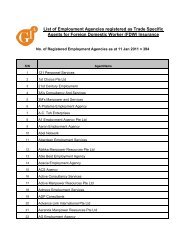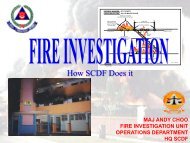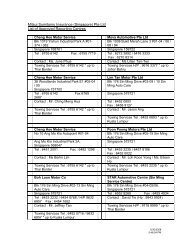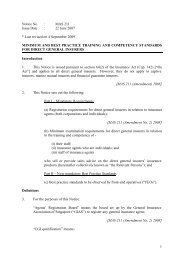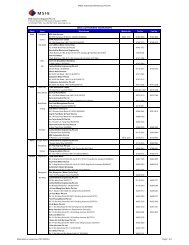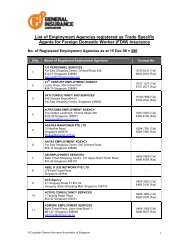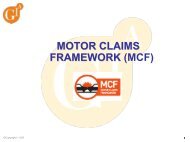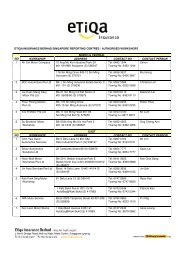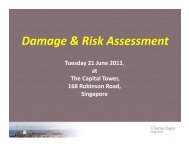CALL FOR ACTION FOR ROAD SAFETY
CALL FOR ACTION FOR ROAD SAFETY
CALL FOR ACTION FOR ROAD SAFETY
You also want an ePaper? Increase the reach of your titles
YUMPU automatically turns print PDFs into web optimized ePapers that Google loves.
<strong>CALL</strong> <strong>FOR</strong> <strong>ACTION</strong> <strong>FOR</strong><br />
<strong>ROAD</strong> <strong>SAFETY</strong>
5 PILLARS OF <strong>ROAD</strong><br />
<strong>SAFETY</strong>
PRESENTED BY:<br />
MR BERNARD TAY<br />
- CHAIRMAN, SINGAPORE <strong>ROAD</strong> <strong>SAFETY</strong> COUNCIL<br />
- PRESIDENT, AA SINGAPORE<br />
- PRESIDENT, FIA REGION II (ASIA & PACIFIC)<br />
- MEMBER, FIA WORLD COUNCIL <strong>FOR</strong><br />
AUTOMOBILE MOBILITY & TOURISM
Introduction<br />
• The Commission for Global Road<br />
Safety was established by the FIA<br />
Foundation with the objective to<br />
examine the framework for, and level of,<br />
international cooperation on road safety,<br />
and to make policy recommendations.
Introduction<br />
• The Commission published its first<br />
report ‘Make Roads Safe: a new priority<br />
for sustainable development’ in June<br />
2006.<br />
• This report will form the basis for the<br />
presentation on the 5 pillars
10 Reasons to Act on Road Deaths<br />
1. 1.3 million people are killed on the<br />
world’s roads each year<br />
2. Road crashes kill more people than<br />
Malaria<br />
3. 50 million people are injured, many<br />
disabled as a result<br />
4. 90% of these casualties occur in<br />
developing countries<br />
Source: Make Roads Safe, Commission for Global Road Safety
10 Reasons to Act on Road Deaths<br />
5. Annual deaths are forecast to rise to<br />
1.9 million by 2020<br />
6. It is the No.1 cause of death for young<br />
people worldwide<br />
7. By 2015, it will be the leading health<br />
burden for children over the age of five<br />
in developing countries<br />
Source: Make Roads Safe, Commission for Global Road Safety
10 Reasons to Act on Road Deaths<br />
8. The economic cost to developing<br />
countries is at least $100 billion a<br />
year<br />
9. Injuries place immense burdens on<br />
hospitals and health systems<br />
10. Road crashes are preventable<br />
Source: Make Roads Safe, Commission for Global Road Safety
Decade of Action for Road Safety<br />
10 Reasons + 10 Years of Action<br />
= Decade of Action<br />
Source: Make Roads Safe, Commission for Global Road Safety
The Goal for a Decade of Action...Saving 5 Million Lives<br />
Source: Make Roads Safe, Commission for Global Road Safety
In November 2009, the First United Nations<br />
Ministerial Conference on Road Safety was<br />
held in Moscow
Decade of Action for Road Safety<br />
• In March 2010, the United Nations has<br />
agreed that 2011-2020 will be the global<br />
Decade of Action for Road Safety<br />
• Singapore is one of the co-sponsors of this<br />
UN resolution.<br />
Source: Make Roads Safe,<br />
Commission for Global Road Safety
Decade of Action for Road Safety<br />
• Through efforts for a Decade of Action for<br />
road safety, road fatalities could be reduced<br />
by 50% from their forecast level for 2020<br />
• This would mean saving five million lives<br />
and avoid 50 million injuries<br />
Source: Make Roads Safe,<br />
Commission for Global Road<br />
Safety
The Singapore Scenario<br />
Fatal Accident Rates per 10k Vehicle Population* (2005 – 2009)<br />
Source: Singapore Traffic Police
No. of Fatalities by Road User Groups<br />
Road User Groups<br />
Motorcyclists & Pillion Riders<br />
Motorcar Drivers & Passengers<br />
Pedestrians<br />
Pedal Cyclists & Pillion Riders<br />
Others (including Bus Passengers/Drivers,<br />
Heavy and Light Goods Vehicles Drivers<br />
and Passengers)<br />
2008<br />
Fatalities<br />
108<br />
(48.9%)<br />
23<br />
(10.4%)<br />
62<br />
(28.0%)<br />
22<br />
(10.0%)<br />
6<br />
(2.7%)<br />
2009<br />
Fatalities<br />
91<br />
(48.4%)<br />
15<br />
(8.0%)<br />
46<br />
(24.5%)<br />
17<br />
(9.0%)<br />
19<br />
(10.1%)<br />
TOTAL 221 188<br />
•Figures in parenthesis denote fatalities as a percentage of total fatalities across all road user groups.<br />
Source: Singapore Traffic Police
What is our Economic Cost<br />
Based on the ADB-ASEAN Regional Road Safety Programme,<br />
Accident Costing Report 2008*:<br />
Summary of Costs per Casualty (S$)<br />
Item<br />
Fatal<br />
1. Lost Output 967,822<br />
2. Medical Costs 12,760<br />
3. Pain, Grief, Suffering 388,219<br />
Total 1,368,800<br />
*Special thanks to author AP Chin Hoong Chor, Asian Development Bank in-country consultant<br />
Total Cost (S$)<br />
Year<br />
Fatal<br />
2008 302,504,800<br />
2009 257,334,400
• In the first half of 2010, there were several<br />
reports on fatal accidents on the roads<br />
• It is very clear that the economic cost of<br />
casualties, both fatal and serious injury, are<br />
very high<br />
• However, lives cannot be measured by<br />
numbers; road users’ life should not become<br />
part of the statistics<br />
• Every life lost on the<br />
roads is one too many<br />
• We should continue to<br />
step up our efforts to<br />
prevent the loss of lives to<br />
road traffic accidents
Safe Systems Approach<br />
• Reaching the 50% goal will require an<br />
implementation plan based on five pillars<br />
drawn from the ‘safe systems’ approach<br />
• Three components in a dynamic system:<br />
• The road user<br />
• The motor vehicle<br />
• The road infrastructure<br />
Source: Make Roads Safe,<br />
Commission for Global Road Safety
5 Pillars of<br />
Road Safety
What are the 5 pillars<br />
1. Building Management Capacity<br />
2. Influencing Road Design & Network<br />
Management<br />
3. Influencing Vehicle Safety Design<br />
4. Influencing Road User Behaviour<br />
5. Improving Post Crash Care
Pillar One:<br />
Building Management Capacity<br />
Creation of multi-sectoral partnerships<br />
and designation of lead agencies with<br />
the capacity to develop national road<br />
safety strategies, plans and targets,<br />
supported by data collection and<br />
evidential research to assess<br />
countermeasure design and monitor<br />
implementation and effectiveness<br />
Source: Make Roads Safe, Commission for Global Road Safety
Pillar One:<br />
Building Management Capacity<br />
• Formation of Singapore Road Safety Council<br />
(SRSC) in February 2010<br />
• Functions of the SRSC:<br />
• Foster closer cooperation among local authorities and<br />
agencies for a holistic approach in all road accident<br />
prevention activities, particularly through campaigns,<br />
training and public education;<br />
• Serve as the official body for Singapore to engage with<br />
other international road safety councils and<br />
programmes in contributing to global road safety<br />
outcomes; and<br />
• Serve as a forum for the exchange of ideas on matters<br />
pertaining to road safety.<br />
Source: SRSC
Pillar Two:<br />
Influencing Road Design &<br />
Network Management<br />
Using road infrastructure<br />
assessment rating and<br />
improved design to raise<br />
the inherent safety of road<br />
networks for the benefit of<br />
all road users, especially<br />
the most vulnerable<br />
Source: Make Roads Safe, Commission for Global Road Safety
Pillar Two:<br />
Influencing Road Design &<br />
Network Management<br />
• Land Transport Authority has done remarkable<br />
work in the areas of road design and network<br />
management<br />
• International Road Assessment Programme<br />
(iRAP) - a non-profit organisation dedicated to<br />
saving lives through safer roads by inspecting<br />
high-risk roads and developing Star Ratings and<br />
Safer Roads Investment Plans
Pillar Two:<br />
Influencing Road Design &<br />
Network Management<br />
• Road Assessment Programmes (RAP) are<br />
now active in more than 50 countries,<br />
including Mexico, China, Vietnam, Australia,<br />
New Zealand, India and Malaysia<br />
• There is also EuroTAP, a European Tunnel<br />
Assessment Programme that assesses the<br />
safety levels and risk potentials of tunnels.<br />
Source: iRAP
Pillar Two:<br />
Influencing Road Design &<br />
Network Management<br />
Safer roads have the capacity to address<br />
key crash types, but also play an important<br />
role in addressing behavioural issues (such<br />
as providing visual cues to slow driver<br />
speeds) and make travel safer for all road<br />
users.<br />
Source: iRAP
Pillar Two:<br />
Influencing Road Design &<br />
Network Management<br />
Example – median safety barriers<br />
physically separate opposing lanes<br />
of traffic. This helps stop vehicles<br />
travelling into opposing traffic<br />
lanes. The barriers can also be<br />
used to limit turning options for<br />
vehicles, and shift these<br />
movements to safer locations.<br />
Median barriers can reduce injuries<br />
by 50% but their use must be<br />
considered carefully because they<br />
may increase speeds and reduce<br />
space for other road users<br />
Source: iRAP
Pillar Three:<br />
Influencing Vehicle Safety Design<br />
Global deployment of improved<br />
vehicle safety technologies, and<br />
accelerate the uptake of new<br />
technologies<br />
Source: Make Roads Safe, Commission for Global Road Safety
Pillar Three:<br />
Influencing Vehicle Safety Design<br />
• Vehicle manufacturers have a responsibility to<br />
produce safe cars. They must meet this<br />
obligation in every market. All cars should be<br />
engineered for safety, and basic safety<br />
measures like air bags should no longer be<br />
considered optional extras.<br />
• Close working relationship between the<br />
authorities and the relevant stakeholders<br />
including car dealers and distributors<br />
• The SRSC has a research sub-committee that<br />
looks into different aspects of road safety
Pillar Three:<br />
Influencing Vehicle Safety Design<br />
Example: eSafety programme<br />
eSafety refers to vehicle technologies that can<br />
assist the driver in an emergency situation and by<br />
providing vital information and warnings to help<br />
avoid the situation occurring in the first place.<br />
Key applications include:<br />
• Electronic Stability Control (ESC)<br />
• Blind Spot Monitoring<br />
• Lane Support Systems<br />
• Speed Alert<br />
• Warning & Emergency Braking Systems<br />
• Adaptive Headlights Source: eSafety Challenge
Pillar Three:<br />
Influencing Vehicle Safety Design<br />
Example: Euro NCAP<br />
• Euro NCAP provides motoring consumers<br />
with a realistic and independent assessment<br />
of the safety performance of some of the<br />
most popular cars sold in Europe.<br />
• Acts as an incentive for manufacturers to<br />
improve the safety of their cars.<br />
Source: Euro NCAP
Pillar Four:<br />
Influencing Road User Behaviour<br />
Through sustained enforcement of road<br />
traffic rules combined with public<br />
awareness/education activities that will<br />
raise compliance with regulations that<br />
reduce the impact of the key risk factors<br />
(non-use of seat belts and helmets, drink<br />
driving and speeding)<br />
Source: Make Roads Safe, Commission for Global Road Safety
Pillar Four:<br />
Influencing Road User Behaviour<br />
Deliver vaccines for road safety<br />
‘Vaccines’ exist to tackle this epidemic and<br />
quickly begin to reduce casualties: using<br />
motorcycle helmets and seat belts;<br />
government action to tackle drink driving,<br />
speeding and to improve driver training and<br />
licensing<br />
Source: Make Roads Safe, Commission for<br />
Global Road Safety
Pillar Four:<br />
Influencing Road User Behaviour<br />
• The Traffic Police has recently launched its<br />
Road Safety Outreach and Road Courtesy<br />
Campaign<br />
• SRSC and AA Singapore will continue to roll<br />
out programmes to promote and raise road<br />
safety awareness to road users<br />
• E.g. AA Singapore will be rolling out<br />
advanced and defensive driving courses for<br />
members
Pillar Five:<br />
Improving Post Crash Care<br />
• To increase responsiveness to<br />
emergencies and improve the ability of<br />
health systems to provide appropriate<br />
emergency treatment and longer term<br />
rehabilitation<br />
• Studies of the effect of improving<br />
organisation and planning of trauma care in<br />
high-income countries have consistently<br />
shown survival gains of between 8% and<br />
50%<br />
Source: Make Roads Safe, Commission for Global Road Safety
Pillar Five:<br />
Improving Post Crash Care<br />
• An integrated system which<br />
– prescribes the appropriate medical and<br />
rehabilitative assistance and care to the<br />
different types of crashes and casualties with<br />
different needs<br />
– is equipped with the right resources -<br />
equipment and appliances as well as trained<br />
personnel – to handle the different types of<br />
crashes
Translating<br />
Words<br />
into Actions
SRSC, AA Singapore and other<br />
stakeholders will be launching a<br />
campaign to encourage all users to<br />
pledge their commitment to support the<br />
Decade of Action
Road Safety is<br />
everyone’s responsibility<br />
Authorities &<br />
Agencies<br />
NGOs<br />
Cyclists<br />
Road Safety is the<br />
responsibility of all<br />
road users<br />
Other stakeholders<br />
Motorists<br />
Pedestrians
Together,<br />
let’s make<br />
our roads safer<br />
for all users
With special thanks to:<br />
• Singapore Traffic Police<br />
• Land Transport Authority<br />
• Singapore Road Safety Council<br />
• Make Roads Safe www.makeroadssafe.org<br />
• Commission for Global Road Safety<br />
• FIA<br />
• FIA Foundation<br />
• United Nations<br />
• World Health Organization<br />
• iRAP<br />
• eSafety Challenge
Drive<br />
Safely



